
- Homepage
- Brand
- Item Length
- Item Width
- Material
- Shape
- Type
- Bowl (19)
- Bowls (9)
- Coaster Set (89)
- Cocktail Shaker (38)
- Coffee Pot (11)
- Decanter (12)
- Dinner Bell (12)
- Door Handle (161)
- Door Handles / Knobs (8)
- Door Knob (14)
- Drawer Pull (62)
- Handle (15)
- Ice Bucket (16)
- Pitcher (29)
- Rug (19)
- Serving Tray (57)
- Set (17)
- Tea Cup & Saucer (10)
- Tea Pot (11)
- Vase (343)
- Other (1395)
French Art Deco Pottery Denbac, Vierzon, Three-Handled Vase, Blue Drip Glaze
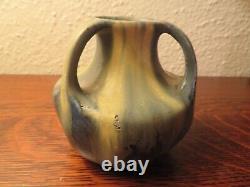

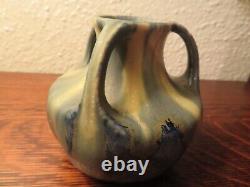


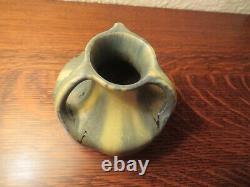
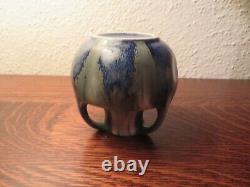

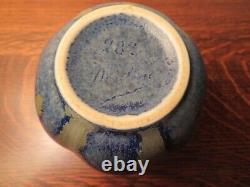
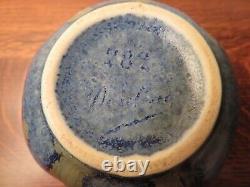


French Art Deco Pottery: Denbac, Vierzon, Three-Handled Vase, Blue Drip Glaze. The City of Vierzon in central France became a center of "the arts of fire" in the early 19. Thanks to the presence of large deposits of high quality clay, the manufacture of porcelain and other ceramics began in the area in 1816 and grew by the late nineteenth century to employ more than 1,500 people in a multitude of family and industrial enterprises. The production of stoneware and other ceramics in Vierzon declined sharply after the Second World War, with the last workshop closing in 1997.
In addition to numerous manufacturers of utilitarian and artistic ceramics, Vierzon was also home to two glassworks, established in 1860 and 1874, the last of which ceased operations in 1957. Fuel for the manufacture of ceramics and glass was transported directly from the Blanzy Basin to Vierzon by the Berry canal. It is in this context that René Denert created a ceramics workshop in Vierzon in 1908, taking advantage of the important ceramic activity that had existed in the city since the beginning of the 19th century. This company, after the arrival of René Louis Balichon in 1910, became in 1921 the Denert Company and Balichon (Denbac). Denert brought with him his experience in working in Golfe-Juan, Vallauris, the most important ceramics center of the South of France. There, at the beginning of the 20. Century, building on a centuries-long tradition of utilitarian ceramic production, the Massier family transformed Vallauris into a leading center for the production of Art Nouveau stoneware. Vitry-le-François (Marne) and married in 1897 at the age of 25. Denert began his career as an intern and then worker at L'Hospied et Cie.A supplier of colors and glazes in the southern France ceramics center of Golfe-Juan. He came to Vierzon and was first employed at the Bouvier factory, a producer of stoneware and majolica. He established his own workshop on rue Camille Desmoulins, where he began production in 1908-9. É Denert was a true artist and friend of the sculptor Dalou and the architect Karcher, who also taught at the. Cole Nationale Professionale in Vierzon.
Balichon was not an artist but came to play a critical role in the commercial success of the enterprise that became Denert and Balichon (Denbac) in 1921. By most accounts, he is credited with the development of Denbac's commercial network, the rationalization of its production, and the development of its catalogues and systematic numbering system for the forms created by René Denert and his artistic collaborators. Following the death of René Denert in 1937, Balichon took over leadership of the business, but production was suspended for the duration of World War II. Balichon died in 1949, after which his descendants were able to keep the business open until 1952. While the names most closely associated with the artistic and commercial success of Denbac over its 40-plus years of production are those of Denert and Balichon, there is a third individual who played an important role but received little recognition. That individual is Monsieur Antigny, who was the long-time leader in the workshop that produced its models and molds. At Denbac, where its artistic and utilitarian stoneware and porcelain was produced by injecting a clay-water slurry, called barbotine, into molds and then fired. Antigny is credited with overseeing the production of and managing the some 15,000 molds necessary for the production of more than 600 Denbac forms. Molds developed for early Art Nouveau pieces were in continuous use until the workshop's closure in 1952.The workshop established in 1909 by René Denert on rue Camille Desmoulins in Vierzon was a small enterprise, but it grew rapidly to become one of the most important producers of French stoneware, reaching its peak in the twenty years between the two World Wars. In the early years, René Denert worked alone with just a few workers and signed pieces with his name or initials, produced in a single square kiln. Beginning in 1918, the enterprise underwent a major expansion, with three additional round kilns, each measuring 15 meters high by six meters in diameter, built over the next three years, dramatically increasing production capacity.
These new kilns allowed firing at the very high temperatures required up to 1,380°C. To produce Denbac's signature " gr ès flames grand feu ". The workshop grew to include a warehouse on the ground floor, where clay was mixed, and workshops responsible for pouring, turning, glazing and finishing on the first floor. At its height, Denbac is reported to have employed 49 workers. Denbac stoneware was produced through a series of processes, with a first firing at 900.
To produce an unglazed, porous earthenware biscuit, which was then glazed and fired at a high temperature for 18-20 hours. Each of the large kilns had two levels and four chambers. Each is reported to have had its own idiosyncrasies, with Denbac's skilled workmen learning which pieces with what glazes should be fired in specific sections of each kiln to produce the best results. Records show a father and son with the surname DROIT.
As long-time employees responsible for tending the kilns. Denbac produced an incredible range and quantity of artistic and utilitarian stoneware, particularly during its heyday in the period between the two world wars. To facilitate the sale of its production through a well-established network of dealers, including some of France's largest department stores, Denbac produced a series of catalogues with pictures and prices for its many forms. The last edition of the catalogue was produced in the 1930s but still contained the early Art Nouveau pieces designed by Ren. Denert in the early 1900s, except in cases where the original model and mold were destroyed or the model was produced on special customer order or withdrawn from production due to limited demand.
From these catalogues it is possible to document the more than 600 known forms produced by Ren. Largely due to the efforts of Ren. Balichon, Denbac's commercial network was well organized, accounting for the enterprise's impressive sales volumes.
This network was anchored by a general agent located on rue de Paradis in Paris, which was responsible for exports, primarily to Britain and Switzerland. In addition, a network of wholesalers was established to deal with buyers, including those of large department stores such as Printemps and Galeries Lafayette. A substantial portion of Denbac's business was the production of bottles, in various sizes in both stoneware and porcelain, for liquor firms, including such well-known producers as Cointreau and Giradot. Denbac also produced stoneware containers for the sale of branded food products, including Grey Poupon mustard from Dijon.
Denbac pieces in both Art Nouveau and Art Deco styles carry a wide range of distinctive glazes. Drip glazes were commonly used, particularly in various combinations of the blue, brown and green glaze families. Applying these glazes to its large number of forms resulted in a staggering number of combinations, with each piece subject to subtle variations resulting from firing at high temperatures in different kilns. Most Denbac production carries a signature, accompanied by a model number. In many cases, however, these model numbers are not visible due to the thickness of the glaze or the age of the mold and its incised signature. The earliest known signature, dating from the workshop's establishment in 1909, is a blue stamped shopmark with René Denert's initials ("RD"), accompanied by Vierzon and the image of a kiln. Subsequently, but prior to the incorporation of Denert & Balichon in 1921, pieces were often signed with a script R.At some point in the 1910s, René Balichon's name was added to the signature, signaling his growing role in the development and management of the enterprise. The name "Denbac" appears to have been coined for marketing purposes by René Balichon circa 1914, but no such legal entity ever existed. Most pieces produced by Denert and Balichon in the workshop on rue Camille Desmoulins in Vierzon over its forty years of operation bear some form of the script "Denbac" signature and it is under this name that RenéDenert's artistic stoneware was known to buyers from the 1920s on, and to collectors today. Pieces with unglazed bottoms bore either an incised signature or a stamped blue "Denbac" shopmark.
In some cases, production destined for export also carried a "FRANCE" or "Made in France" designation as part of the signature. Later production was completely dipped in glaze, including the bottoms.
Some pieces produced during the transition period bear the blue stamped Denbac signature, protected by wax prior to dipping the piece in glaze. Most later production carries the incised script Denbac signature from the mold, under glaze. It is not uncommon for such pieces, produced until the workshop's closure in 1952, to show no visible signature due to a faint imprint and heavy glaze coverage. Due to their very recognizable forms, however, such pieces can still safely be identified as Denbac.This three-handled vase is an instantly recognizable Denbac form in an Art Deco style, glazed in an unusual crystalline blue contrasting with a matte pale cream glaze. This vase is signed with the underlined script Denbac signature under the glaze, along with a model number (282). The condition of the piece is excellent, with no observed flaws. The dimensions of this striking little vase are approximately 3.5 inches high by 4 inches wide at its widest point. This item is part of a collection of Denbac vases, primarily in brown and blue glazes, that I will be listing in the coming weeks.
Please see my other listings for Denbac pieces that would complement this vase. The bulk of my collection is Danish stoneware from the 1920s into the 1970s. The bulk of my Danish collection consists of Arne Bang, Saxbo, Jais Nielsen, Nils Thorsson, Erik Hjorth, and Ejvind Nielsen. I have done extensive research on these and other artists and workshops and would be happy to share that with interested buyers.
I also have substantial collections of American, French, Belgian and other 20th century northern European art pottery. The bulk of my French/Belgian collection consists of Pierrefonds, Denbac, Charles and Pierre Greber, and Roger Guerin, with some pieces from other workshops, including Gilbert Metenier and Alphones Cytere. Over the coming months I will be listing a wide range of pieces from my collection.
Please check out my other listings and add me to your list of saved sellers to receive notification of new listings.

